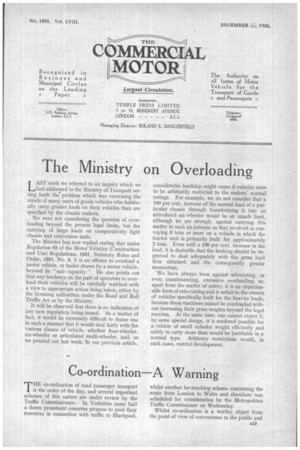The Ministry on Overloading
Page 19

If you've noticed an error in this article please click here to report it so we can fix it.
LAST week we referred to an inquiry which we La had addressed to the Ministry of Transport setting forth the-problem which was exercising the minds of many users of goods vehicles who habitually carry greater loads on their vehicles than are specified by the chassis makers.
We were not considering the question of overloading beyond the present legal limits, but the carrying of large loads on comparatively light chassis and conversion units.
The Minister has now replied stating that under Regulation 62 of the Motor Vehicles (Construction and Use) Regulations, 1931, Statutory Rules and Order, 1931, No. 4, it is an offence to overload a motor vehicle, or trailer drawn by a motor vehicle, beyond its "safe capacity." He also points out that any tendency on the part of operators to overload their vehicles will be carefully watched with a view to appropriate action being taken, either by the licensing authorities under the Road and Rail Traffic Act or by the Ministry. .
It will be observed that there is no indication of any new regulation being issued. As a matter of fact, it would be extremely difficult to frame one in such a manner that it would deal fairly with the various classes of vehicle, whether four-wheeler, six-wheeler or articulated multi-wheeler, and, as we pointed out last week, In our previous article, considerable hardship might ensue if vehicles were to be arbitrarily restricted to the makers' normal ratings. For example, we do not consider that a 100 per cent, increase of the normal load of a particular chassis through transforming it into an articulated six-wheeler would be an unsafe limit, although we are strongly against carrying this matter to such an extreme as that involved in conveying 6 tons or more on a vehicle in which the tractor unit is primarily built for approximately 2 tons. Even with a 100 per cent. increase in the load, it is desirable that the braking should be improved to deal adequately with the gross load thus obtained and the consequently greater momentum.
We have always been against advocating, or even countenancing, excessive overloading, as, apart from the matter of safety, it is an objectionable form of rate-cutting and is unfair to the owners of vehicles specifically built for the heavier loads, because thess machines cannot be overloaded without increasing their gross weights beyond the legal maxima. At the same time, one cannot object if, by some special design, it is rendered possible for a vehicle of small unladen weight efficiently and safely to carry more than would be justifiable in a normal type. Arbitrary restrictions would, in such cases, restrict development.












































































